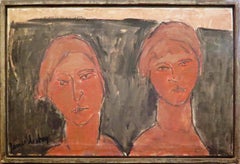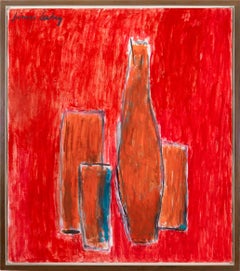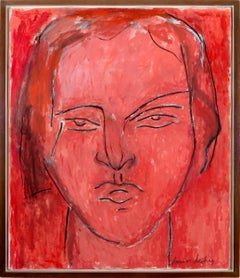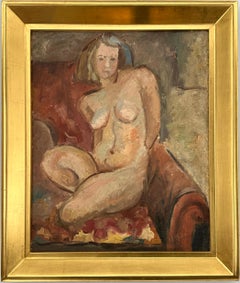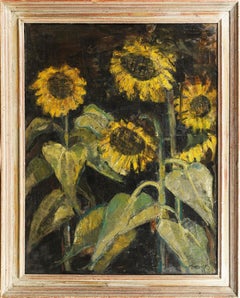James Lechay Paintings
to
5
5
3
2
1
3
1
Overall Height
to
Overall Width
to
4
1
1
1
1
1
5
1
6
837
655
649
610
5
5
5
5
Artist: James Lechay
"Two Women"
By James Lechay
Located in Lambertville, NJ
James Lechay was a painter of figures, landscapes, cityscapes and still lifes who played a notable role in the tradition of avant-garde painting in New York and in the Midwest. An ar...
Category
20th Century American Modern James Lechay Paintings
Materials
Canvas, Oil
"Pink Vase with Flowers"
By James Lechay
Located in Lambertville, NJ
Jim’s of Lambertville is proud to offer this artwork by:
James Lechay (1907 – 2001)
Born in the Bronx in 1907, James Lechay spent most of his childhood in Brooklyn before moving to Joilet, Illinois at age 13 to live with his uncle after his mother passed away. In 1928, he received his B.A. in psychology from the University of Illinois. The next year, he attended one week of graduate school before leaving to study under his brother, the painter Myron Lechay, in New York. At his brother’s studio, James began to associate with other artists of the time such as Milton Avery, Mark Rothko, Arshile Gorky, William Zorach, and Raphael and Moses Soyer. From Myron, James Lechay learned to train his eye to observe natural forms and developed a philosophy dependent upon the relationship built between the artist and the subject.
Lechay became engaged in the social and political issues of Depression-era New York and even joined the social realism movement for a brief time in the 1930s. He operated as the leader of the Artists Union while employed by the Works Progress Administration (WPA). With the WPA, Lechay traveled to Las Vegas, New Mexico, where he established a gallery and exhibited the works of Milton Avery, Max Weber, and other WPA artists. Despite his association with many artists and artistic communities in New York in the 1930s and 40s, Lechay opposed adopting a style due to its popularity and commercial success. His use, however, of large brushstrokes from Abstract Expressionism, the flattened plane of Modernism, and the simple compositions of early Abstraction created a combination of styles completely his own.
A painter of a vast range of subjects, including still lifes, portraits, and landscapes, Lechay was known to reduce these forms to their visual essentials. Lechay often did not date his paintings as he frequently reworked them, even after they were exhibited, calling his pieces, “finished at all stages and never finished”.
In 1945, Lechay was hired by the University of Iowa’s art department, where he worked alongside Mauricio Lasansky, Humbert Albrizio, Carl Fracassini, and Byron Burford...
Category
1990s Abstract James Lechay Paintings
Materials
Canvas, Oil
"Bottle & Glasses"
By James Lechay
Located in Lambertville, NJ
Jim’s of Lambertville is proud to offer this artwork by:
James Lechay (1907 – 2001)
Born in the Bronx in 1907, James Lechay spent most of his childhood in Brooklyn before moving to Joilet, Illinois at age 13 to live with his uncle after his mother passed away. In 1928, he received his B.A. in psychology from the University of Illinois. The next year, he attended one week of graduate school before leaving to study under his brother, the painter Myron Lechay, in New York. At his brother’s studio, James began to associate with other artists of the time such as Milton Avery, Mark Rothko, Arshile Gorky, William Zorach, and Raphael and Moses Soyer. From Myron, James Lechay learned to train his eye to observe natural forms and developed a philosophy dependent upon the relationship built between the artist and the subject.
Lechay became engaged in the social and political issues of Depression-era New York and even joined the social realism movement for a brief time in the 1930s. He operated as the leader of the Artists Union while employed by the Works Progress Administration (WPA). With the WPA, Lechay traveled to Las Vegas, New Mexico, where he established a gallery and exhibited the works of Milton Avery, Max Weber, and other WPA artists. Despite his association with many artists and artistic communities in New York in the 1930s and 40s, Lechay opposed adopting a style due to its popularity and commercial success. His use, however, of large brushstrokes from Abstract Expressionism, the flattened plane of Modernism, and the simple compositions of early Abstraction created a combination of styles completely his own.
A painter of a vast range of subjects, including still lifes, portraits, and landscapes, Lechay was known to reduce these forms to their visual essentials. Lechay often did not date his paintings as he frequently reworked them, even after they were exhibited, calling his pieces, “finished at all stages and never finished”.
In 1945, Lechay was hired by the University of Iowa’s art department, where he worked alongside Mauricio Lasansky, Humbert Albrizio, Carl Fracassini, and Byron Burford...
Category
20th Century Abstract James Lechay Paintings
Materials
Canvas, Oil
"City View"
By James Lechay
Located in Lambertville, NJ
Jim’s of Lambertville is proud to offer this artwork by:
James Lechay (1907 – 2001)
Born in the Bronx in 1907, James Lechay spent most of his childhood in Brooklyn before moving to Joilet, Illinois at age 13 to live with his uncle after his mother passed away. In 1928, he received his B.A. in psychology from the University of Illinois. The next year, he attended one week of graduate school before leaving to study under his brother, the painter Myron Lechay, in New York. At his brother’s studio, James began to associate with other artists of the time such as Milton Avery, Mark Rothko, Arshile Gorky, William Zorach, and Raphael and Moses Soyer. From Myron, James Lechay learned to train his eye to observe natural forms and developed a philosophy dependent upon the relationship built between the artist and the subject.
Lechay became engaged in the social and political issues of Depression-era New York and even joined the social realism movement for a brief time in the 1930s. He operated as the leader of the Artists Union while employed by the Works Progress Administration (WPA). With the WPA, Lechay traveled to Las Vegas, New Mexico, where he established a gallery and exhibited the works of Milton Avery, Max Weber, and other WPA artists. Despite his association with many artists and artistic communities in New York in the 1930s and 40s, Lechay opposed adopting a style due to its popularity and commercial success. His use, however, of large brushstrokes from Abstract Expressionism, the flattened plane of Modernism, and the simple compositions of early Abstraction created a combination of styles completely his own.
A painter of a vast range of subjects, including still lifes, portraits, and landscapes, Lechay was known to reduce these forms to their visual essentials. Lechay often did not date his paintings as he frequently reworked them, even after they were exhibited, calling his pieces, “finished at all stages and never finished”.
In 1945, Lechay was hired by the University of Iowa’s art department, where he worked alongside Mauricio Lasansky, Humbert Albrizio, Carl Fracassini, and Byron Burford...
Category
20th Century Abstract James Lechay Paintings
Materials
Canvas, Oil
"Seriously!"
By James Lechay
Located in Lambertville, NJ
Signed lower right
Jim’s of Lambertville is proud to offer this artwork by:
Rex Ashlock (1918 – 1999)
Born in Spokane, Washington in 1918 Rex Ashlock was known for his abstract, f...
Category
20th Century Abstract James Lechay Paintings
Materials
Canvas, Oil
Related Items
The Artist's Wife oil painting by Hans Burkhardt
By Hans Burkhardt
Located in Hudson, NY
Hans Burkhardt
The Artist's Wife (1930)
Oil on canvas, 20" x 16"
24" x 20 ½" x 1 ½" framed
Dated 1930 lower right recto. Annotated "To Elsa HB Louise Burkhardt 1930. HB" verso.
...
Category
1930s American Modern James Lechay Paintings
Materials
Oil, Canvas
American School Signed Framed Modernist Large Sunflower Still Life Oil Painting
Located in Buffalo, NY
Antique American modernist signed sunflower still life oil painting. Oil on canvas. Signed. Framed. Image size, 28L x 36H.
Category
1970s Abstract James Lechay Paintings
Materials
Canvas, Oil
H 41 in W 33 in D 2 in
"Winter" American Modernism WPA Regionalism Landscape Mid-Century Magic Realism
By Dale Nichols
Located in New York, NY
"Winter" American Modernism WPA Regionalism Landscape Mid-Century Magic Realism. 30 x 40 inches. Oil on canvas, c. 1960s, Signed lower right.
As we list the painting now, the work is currently being cleaned, restored and a hand carved frame is being built. Additional photos will be uploaded as soon as possible.
Our gallery, Helicline Fine Art, just launched our new digital exhibition: American Art: The WPA and Beyond. Three dozen paintings, works on paper and sculptures which are available here on 1stDibs. In person viewings can be arranged by appointment at our midtown Manhattan gallery.
Provenance:
"Winter" was originally purchased by Stanley Byer. Mr. Byer owned homes in Key West, New York City, and Washington, D.C. He purchased the painting from Dunning Auction in 1984 in Elgin, Illinois. Mr. Byer was related to Abraham Weiss from Florida. Saul Babbin, now deceased was a cousin of Mr. Weiss. I purchased the painting from Joy Babbin, Mr. Babbin's wife, now living in from New Mexico.
Dale Nichols (1905 – 1995) Artist, printmaker, illustrator, watercolorist, designer, writer and lecturer, Nichols did paintings that reflected his rural background of Nebraska where he was born in David City, a small town. Although he did much sketching outdoors, most of his paintings were completed in his studio and often included "numerology, magic squares...
Category
1960s American Modern James Lechay Paintings
Materials
Oil, Canvas
Riders of Pigeon Hill
By Jon Corbino
Located in Los Angeles, CA
Riders of Pigeon Hill, c. 1940s, oil on canvas, signed lower right, 24 x 36 inches, label verso with title, artist’s name and address; same information inscribed verso; ex-collection...
Category
1940s American Modern James Lechay Paintings
Materials
Canvas, Oil
Fruit Cluster
By James Koenig
Located in Buffalo, NY
An original modern abstract by American artist James Koenig. This work created in 1954 is featured in the Draw Near exhibition currently on view at Benjaman Gallery.
Category
1950s Abstract James Lechay Paintings
Materials
Canvas, Oil
Incredible Antique American Abstract Expressionist Flower Study Oil Painting
Located in Buffalo, NY
Rare original abstract painting by Eric Chan. Oil on canvas.
Category
Early 2000s Abstract James Lechay Paintings
Materials
Canvas, Oil
Misty Morning, Chromatic Collision Series, Abstract Geometric Line Painting
By Robert Petrick
Located in Los Angeles, CA
Robert Petrick's "Misty Morning" is a compelling abstract oil painting that masterfully captures the essence of a tranquil and elusive early morning atmosphere through geometric prec...
Category
21st Century and Contemporary Abstract Geometric James Lechay Paintings
Materials
Canvas, Oil
H 52 in W 40 in D 1.5 in
The Demogogue
Located in Los Angeles, CA
The Demagogue or Tale in a Tub, 1952, oil on canvas, 20 x 24 inches, signed, titled, and dated verso
About the Painting
The Demagogue is an iconic Bendor Mark painting from the prime of his post-war period. Beginning early in his career, Mark was fascinated with depictions of the human figure and their capacity to tell stories of the world around him. Mark was a keen observer of his times and in The Demagogue we see Mark’s portrayal of a faithless politician holding up a “V” for victory sign as he appeals to the wanton desires and prejudices of the masses. Below the demagogue is a swirl of humanity representing the common man who is being pushed down by the powerful, while the robed figure of liberty with her scales of justice held high is brushed aside. Behind the demagogue, Mark places two other powerful supporting institutions which were often co-opted by the world’s dictators, the Church and the Military. Mark was an internationalist, so it is difficult to know exactly which demagogue inspired him to create this work, but in 1952 there were many to choose from. Whether depicting Argentina’s Peron (the demagogue and the women to the right resemble Juan and Eva Peron), Spain’s Franco or the United States’ homegrown fear mongers like Joseph McCarthy, Mark tells a universal story that unfolded in dramatic fashion during the post-war period as nations and their peoples grappled with authoritarianism and anti-democratic impulses. Stylistically, The Demagogue draws on the elements which make Mark’s work from this period immediately recognizable, a saturated palette, a closely packed and frenetic composition, exaggerated figuration and stylized facial features. But, above all, we see Mark’s ability to tell the stories of the rich and powerful and their ability to oppress. Like Mark’s work in the collection of the Whitney Museum of American Art (The Hourglass - 1950-51) and the Los Angeles County Museum of Art (Execution – 1940), The Demagogue pulls no punches, as the artist lays bare the threats to freedom and basic human rights.
About the Artist
Bendor Mark was an American modernist and social realist painter. Born as Bernard Marcus on June 5, 1912, in Brooklyn, New York, Mark trained at The Cooper Union during the 1920s where he studied with William Brantley van Ingen and became a prize-winning artist with a focus on painting the human figure. After his time at Cooper, Mark continued to live in New York and worked as a commercial artist and textile designer in addition to his pursuit of a career in painting. Like many Depression Era artists, Mark engaged with social progressives and in 1934, he joined the Artist’s Union which had the goal of advancing artists’ position as “worker.” Mark’s painting, Restaurant, which is now in the permanent collection of the Smithsonian American Art Museum, appeared in the February 1936 edition of the Union’s publication, Art Front, as part of a review of an exhibition at ACA Gallery in New York.
Mark worked on the Federal Art Project and by the mid- to late-1930s, began a series of paintings exploring the working conditions and hazards of the mining industry. Mark believed that miners were “in the forefront of the struggle for emancipation” and that the mere “struggle for existence is like moving mountains.” He became passionate about the Spanish Civil War and painted sympathetic images in support of the Spanish Republic. Mark was a premature anti-fascist and throughout his career painted works critical of dictators and other oppressors. During the late 1930s, Mark entered mural competitions with designs influenced by the Mexican muralists, taught adult art education in Queens, New York, and was an instructor at the WPA’s Queensboro Art Center. He was so committed to socially progressive art that by 1934, he had changed his name to Bendor Mark, in part, to distinguish his social realist paintings from his earlier work.
During World War II, Mark worked as an artist for military contractors. After the war, he was employed as a graphic artist and in the printing industry before moving to Southern California in 1948, where he returned to a fine art practice the following year with politically and socially charged images which reflected his view of the shortcomings of the post-War period, the continued threat of fascism, and the international tensions of the Cold War. As the mood of the country shifted towards the right during the McCarthy Era and the art world’s attention focused on abstraction at the expense of figuration, Mark’s career as a painter suffered.
From the 1950s through the 1980s, Mark continued to depict the events that shaped the world around him, often employing a highly stylized approach characterized by dynamic multi-figure compositions, a subtle muted palette, and exaggerated expressive features. A review of Mark’s oeuvre suggests that few people escaped Mark’s attention. He painted presidents, prime ministers, royalty, evangelists, musicians, and dictators (and their henchman), along with miners, farm workers, the urban poor, protesters, the unemployed and dispossessed. He laid bare the arrogance, cruelty, and hypocrisy of the world’s elites. Mark noted, “A work of art cannot be fully appreciated or wholly understood without considering the socio-political and cultural ambience that gave it birth.” He continued, “I have the ability to foresee the direction of social and political events while they are actually taking place.” He was not himself a direct political activist, however. Although Mark commented, “It’s a misconception to separate art from the social aspect of life,” he viewed artists as being neutral. According to Mark, “An apolitical attitude reflects the fact that the artist is passive. . . An artist never affects society; he merely reflects it.”
In addition to the Mexican Muralists, Mark was influenced by the old masters Rembrandt, Michelangelo, and Masaccio, as well as the more modern master, Van Gogh. Mark’s writings directly acknowledge these influences and archival material from his estate includes magazine articles, pamphlets and transparencies related to these artists. Mark also collected materials related to several of his social realist contemporaries, including Reginald Marsh, Ben Shahn, Leonard Baskin, and Raphael Soyer, who was Mark’s good friend. For years, Soyer sent Mark holiday cards and Soyer inscribed a message of friendship on a self-portrait he gifted to Mark in the 1970s, all of which are still held in the collection of Mark’s family.
From the late 1920s through the mid-1950s, Mark’s work was well received. His paintings won prizes and were accepted into major juried exhibitions including at the Brooklyn Museum, the New York World’s Fair and the Metropolitan Museum of Art. He gained national recognition for paintings depicting the oppressed and the common worker. Despite the decline in popularity of representational art during the 1950s and 1960s, Mark stayed true to his interest in depicting the human figure and by the last two decades of his life, his work underwent a reassessment as curators included Mark’s paintings in exhibitions showcasing the role of labor in art during the Depression Era. This recognition continued in recent years when Mark was honored by having his work included in the Whitney Museum of American Art’s ground-breaking exhibition, Vida Americana, which explored the pioneering role that the Mexican muralists played in the development of modern American art during the inter-war period. The influence of Rivera, Siqueiros and Orozco on Mark is unmistakable and his paintings from the 1950s (and beyond) sit comfortably in dialogue with other Los Angeles artists who continued to paint in the social realist tradition long after the mainstream art world had moved toward abstraction. Mark’s concern for underserved Brown and Black communities was shared with artists such as Charles White and his ally, Edward Biberman...
Category
Mid-20th Century American Modern James Lechay Paintings
Materials
Oil, Canvas
Oil on Canvas “Arroyo 14”
By Frank Arnold
Located in Fresno, CA
" Arroyo 14" is 72” x 60”. A rich sienna and ochre figure centered on a textured field of light yellows and beige. Frank Arnold’s paintings exhibit the highest quality materials for ...
Category
2010s Abstract James Lechay Paintings
Materials
Canvas, Oil
Antique American School Abstract Expressionist Hat Shop Brilliant Oil Painting
Located in Buffalo, NY
Vintage modernist abstract hat shop painting. Oil on canvas, circa 1950. Housed in a period frame. Image size, 32L x 26H.
Category
1940s Abstract Expressionist James Lechay Paintings
Materials
Canvas, Oil
H 27 in W 33 in D 2 in
“Girl in the Grass”
By Anton Refregier
Located in Southampton, NY
Original oil on canvas painting by Anton Refregier of a young girl resting in the grass. Signed upper right and dated 1962. Condition is very good. The painting is in its original oa...
Category
1960s American Modern James Lechay Paintings
Materials
Oil, Canvas
Original-CamelliasPink WillowTree-Abstract-Weaver-feat.Tartan-UK Awarded Artist
Located in London, GB
2024, Shizico Yi takes on an innovative project - "The Weaver," it's inspired by the heritage of family's Tartan, the rich lineage and history of the Clan. Within the patterns of fam...
Category
2010s Abstract Expressionist James Lechay Paintings
Materials
Gesso, Oil, Acrylic, Canvas
H 19.53 in W 15.56 in D 0.6 in
Previously Available Items
Antique American Modernist Portrait Oil Painting, Young Woman by James Lechay
By James Lechay
Located in Buffalo, NY
Modernist portrait painting by James Lechay (1907 - 2001). Oil on canvas, circa 1930. Signed lower left. Displayed in a modernist frame. Image size, 10"L x 12"H.
Category
1930s Modern James Lechay Paintings
Materials
Canvas, Oil
H 18.5 in W 16.5 in D 3 in
"Arrangement with Four Leaves"
By James Lechay
Located in Lambertville, NJ
Signed on verso & estate stamped
Jim’s of Lambertville is proud to offer this artwork by:
James Lechay (1907 - 2001)
James Lechay was active/lived in Massachusetts, Iowa. James L...
Category
20th Century Abstract James Lechay Paintings
Materials
Canvas, Oil
"Have a Good Day"
By James Lechay
Located in Lambertville, NJ
James Lechay was a painter of figures, landscapes, cityscapes and still lifes who played a notable role in the tradition of avant-garde painting in New York and in the Midwest. An ar...
Category
20th Century Abstract Impressionist James Lechay Paintings
Materials
Mixed Media, Paper
"Two Bottles with Green"
By James Lechay
Located in Lambertville, NJ
James Lechay was a painter of figures, landscapes, cityscapes and still lifes who played a notable role in the tradition of avant-garde painting in New York and in the Midwest. An ar...
Category
20th Century Abstract Impressionist James Lechay Paintings
Materials
Board, Oil
James Lechay paintings for sale on 1stDibs.
Find a wide variety of authentic James Lechay paintings available for sale on 1stDibs. If you’re browsing the collection of paintings to introduce a pop of color in a neutral corner of your living room or bedroom, you can find work that includes elements of orange, red and other colors. You can also browse by medium to find art by James Lechay in canvas, fabric, oil paint and more. Much of the original work by this artist or collective was created during the 20th century and is mostly associated with the abstract style. Not every interior allows for large James Lechay paintings, so small editions measuring 24 inches across are available. Customers who are interested in this artist might also find the work of Joseph Glasco, Kristy Chettle, and Leonard Nelson. James Lechay paintings prices can differ depending upon medium, time period and other attributes. On 1stDibs, the price for these items starts at $7,450 and tops out at $15,625, while the average work can sell for $14,375.
